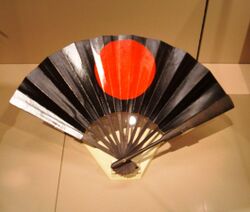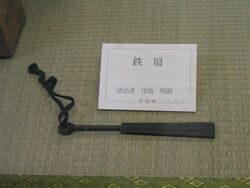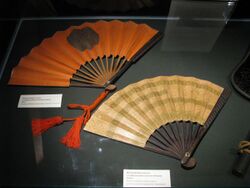Engineering:Japanese war fan
The Japanese war fan, or tessen (Japanese: 鉄扇,てっせん, romanized: tessen, lit. '"iron fan"'), is a weaponized Japanese hand fan designed for use in warfare. Several types of war fans were used by the samurai class of feudal Japan and each had a different look and purpose.
Description
War fans varied in size, materials, shape, and use. One of the most significant uses was as a signalling device.[1] Signalling fans came in two varieties:
- a folding fan that has wood or metal ribs with lacquered paper attached to the ribs and a metal outer cover
- a solid open fan made from metal and/or wood, very similar to the gunbai used today by sumo referees.[2]
The commander would raise or lower his fan and point in different ways to issue commands to the soldiers, which would then be passed on by other forms of visible and audible signalling.[3]
War fans could also be used as weapons. The art of fighting with war fans is tessenjutsu.[1]
Types of Japanese war fans
- Tessen were folding fans with outer spokes made of heavy plates of iron which were designed to look like normal, harmless folding fans or solid clubs shaped to look like a closed fan. Samurai could take these to places where swords or other overt weapons were not allowed, and some swordsmanship schools included training in the use of the tessen as a weapon. The tessen was also used for fending off knives and darts, as a throwing weapon, and as an aid in swimming.[3]
- Gunbai were large solid open fans that could be solid iron, metal with wooden core, or solid wood, which were carried by high-ranking officers.[4] They were used to ward off arrows,[citation needed] as a sunshade, and to signal to troops.[5][6]
War fans in history and folklore
One particularly famous legend involving war fans concerns a direct confrontation between Takeda Shingen and Uesugi Kenshin at the fourth battle of Kawanakajima. Kenshin burst into Shingen's command tent on horseback, having broken through his entire army, and attacked; his sword was deflected by Shingen's war fan. It is not clear whether Shingen parried with a tessen, a dansen uchiwa, or some other form of fan. Nevertheless, it was quite rare for commanders to fight directly, and especially for a general to defend himself so effectively when taken so off-guard.
Minamoto no Yoshitsune is said to have defeated the great warrior monk Saitō Musashibō Benkei with a tessen.
Araki Murashige is said to have used a tessen to save his life when the great warlord Oda Nobunaga sought to assassinate him. Araki was invited before Nobunaga, and was stripped of his swords at the entrance to the mansion, as was customary. When he performed the customary bowing at the threshold, Nobunaga intended to have the room's sliding doors slammed shut onto Araki's neck, killing him. However, Araki supposedly placed his tessen in the grooves in the floor, blocking the doors from closing.[3] His tessen saved his life that day.
The Yagyū clan, sword instructors to the Tokugawa shōguns, included tessenjutsu in their martial arts school, the Yagyū Shinkage-ryū.
Gallery
See also
References
- ↑ 1.0 1.1 William E. Deal, Handbook to Life in Medieval and Early Modern Japan, p.167
- ↑ Louis Frédéric, Japan Encyclopedia, p.267
- ↑ 3.0 3.1 3.2 Oscar Ratti, Adele Westbrook, Secrets of the Samurai: A Survey of the Martial Arts of Feudal Japan, p.296-304
- ↑ Jōchi Daigaku, JSTOR (Organization), Monumenta Nipponica, Volume 16, pp. 71–73
- ↑ Karl M. Schwarz, Netsuke Subjects: A Study on the Netsuke Themes with Reference to Their Interpretation and Symbolism, p. 116
- ↑ A Glossary of the Construction, Decoration and Use of Arms and Armor: In All Countries and in All Times, George Cameron Stone, Courier Dover Publications, 1999, p. 256
Sources
- Oscar Ratti and Adele Westbrook, Secrets of the Samurai, Edison, NJ: Castle Books (1973).
sv:Tessen










